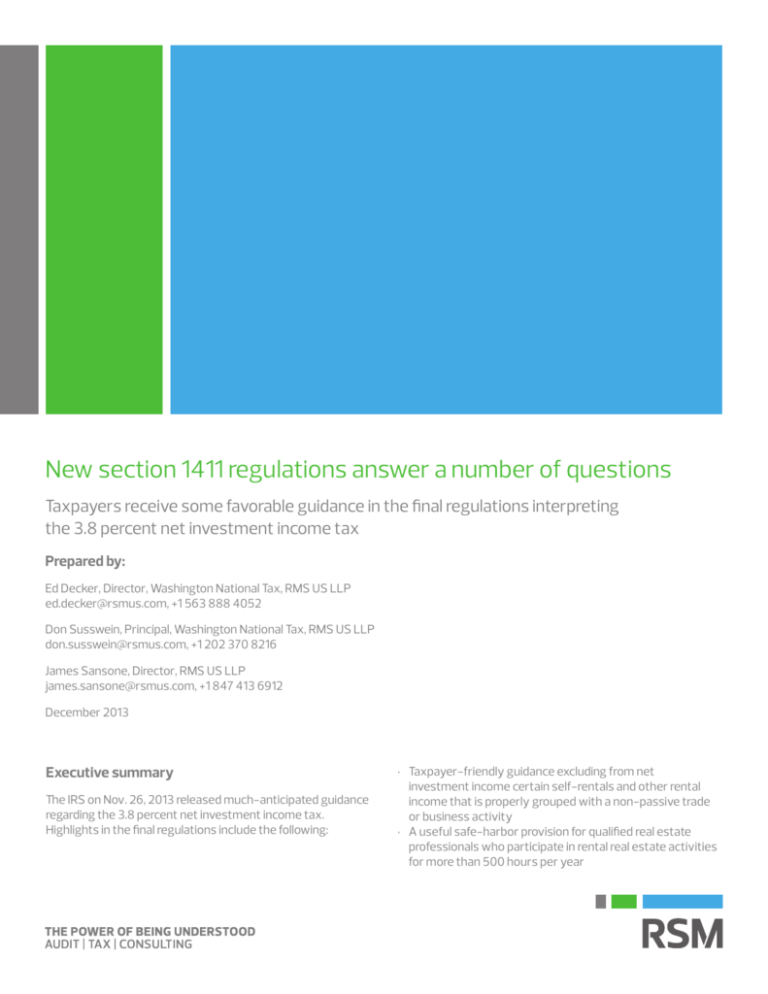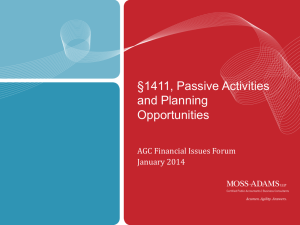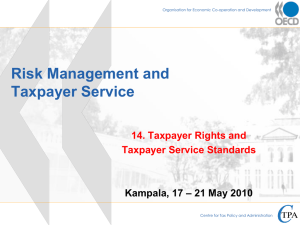
New section 1411 regulations answer a number of questions
Taxpayers receive some favorable guidance in the final regulations interpreting
the 3.8 percent net investment income tax
Prepared by:
Ed Decker, Director, Washington National Tax, RMS US LLP
ed.decker@rsmus.com, +1 563 888 4052
Don Susswein, Principal, Washington National Tax, RMS US LLP
don.susswein@rsmus.com, +1 202 370 8216
James Sansone, Director, RMS US LLP
james.sansone@rsmus.com, +1 847 413 6912
December 2013
Executive summary
The IRS on Nov. 26, 2013 released much-anticipated guidance
regarding the 3.8 percent net investment income tax.
Highlights in the final regulations include the following:
• Taxpayer-friendly guidance excluding from net
investment income certain self-rentals and other rental
income that is properly grouped with a non-passive trade
or business activity
• A useful safe-harbor provision for qualified real estate
professionals who participate in rental real estate activities
for more than 500 hours per year
• Taxpayer-friendly revisions that will, in some cases, allow
taxpayers with losses in excess of gains from property
dispositions to offset other investment or business income
with the excess losses
• Favorable changes with respect to calculating allowable
deductions for items such as investment expenses
The guidance also includes new proposed regulations dealing
with issues that were either not previously addressed by
the IRS or that involved significant modifications from the
previously proposed regulations. This guidance includes
rules governing guaranteed payments to partners and rules
governing the disposition of an ownership interest in a nonpassive S corporation or partnership.
Taxpayers and their advisors should review these new rules
carefully, as there may be opportunities to mitigate the impact
of the 3.8 percent tax.
Analysis
Beginning in 2013, certain taxpayers are subject to a new
3.8 percent tax on various categories of unearned income.
That tax, often referred to as the net investment income tax,
was enacted via the addition of section 1411 to the Internal
Revenue Code as part of the Health Care and Education
Reconciliation Act of 2010. This new tax regime applies to
individuals, estates and trusts. In general terms, for individuals,
the net investment income tax is imposed on the lesser of 1)
the taxpayer’s net investment income, or 2) the taxpayer’s
modified adjustment gross income in excess of a specified
threshold. Similar rules apply to estates and trusts. By statute,
net investment income comprises three categories of income:
• Gross income from interest, dividends, annuities, royalties
and rents, other than such income that is derived in the
ordinary course of a trade or business,
• Trade or business income from a passive activity with
respect to the taxpayer or related to trading in financial
instruments, and
• Net gains attributable to the disposition of property
(other than property utilized in a “non-trading” trade
or business that is non-passive to the taxpayer).
The sum of these three categories is reduced by “properly
allocable deductions” to arrive at net investment income.
To provide taxpayers with guidance on the application of this
tax, the IRS on Nov. 30, 2012, released proposed regulations
outlining rules in a number of areas. Following a review of
public comments, the IRS released final regulations (T.D. 9644)
on Nov. 26, 2013. These final regulations retained many of the
provisions from the proposed regulations but also modified
certain aspects of the proposed regulations and clarified
the application of other rules. The final regulations continue
to apply many passive activity rules to the net investment
income tax. The IRS also released new proposed regulations
(REG-130843-13) addressing certain issues that either were
not previously discussed in the 2012 proposed regulations,
or that were modified so significantly that the IRS wanted to
provide taxpayers with an opportunity to comment prior to
issuing the rules in final form.
Most provisions of the final regulations are effective for
taxable years beginning after Dec. 31, 2013. For 2013,
taxpayers may rely on either the final regulations or the
proposed regulations released in November 2012. The
discussion that follows starts by highlighting the major
changes and clarifications in the final regulations. It then
outlines the major provisions of the new proposed regulations.
Final regulations – major provisions
Trade or business definition
The major category of investment income exempt from the
tax is income from a trade or business in which the taxpayer
materially participates under the passive activity rules
of section 469 (excluding the business of trading certain
financial instruments). Accordingly, a major interpretive
question relates to the definition of a “trade or business” for
these purposes. The IRS declined to provide any guidance
on this question, pointing out that the same issue arises in
many other areas of the tax law and suggesting that existing
guidance in those areas should be sufficient.
Self-rentals
Despite the absence of a general definition of trade or
business, the final regulations provide a very useful rule for
so-called “self-rental” income, which typically arises when
a business segregates its real estate in a separate legal
entity for asset protection purposes and pays rent to the
separate entity. In a typical situation, the real estate is held
in a partnership or limited liability company (LLC), and the
operating business is conducted in an S corporation, with the
S corporation paying rent to the partnership or LLC. Although
taxpayers typically employ this structure for non-tax reasons,
the IRS historically has been concerned that this structure
can be used as a mechanism to generate passive partnership
income that could be used to absorb passive losses from other
unrelated sources, which would not otherwise be allowed. As a
consequence, the passive activity regulations recharacterize
such income (i.e., self-rental income) as non-passive in
certain circumstances. When the 2012 proposed section 1411
regulations were issued, commentators expressed concerns
that it might be difficult to satisfy the IRS that the activities
of the landlord entity were undertaken as part of a trade or
business, even if the tenant entity were clearly so engaged.
The juxtaposition of the passive regulations and the net
investment tax regulations presents two questions. First,
does the recharacterization of self-rental income to nonpassive status apply for purposes of the net investment
income tax? Second, if the recharacterization rule does apply,
does the rental activity need to rise to trade or business status
in order to avoid application of section 1411? Fortunately, the
final regulations provide favorable guidance on both points.
The regulations clearly state that self-rental income retains
its non-passive status for purposes of the net investment
income tax if the individual owner is materially participating
in the business. The regulations also explicitly state that such
income is deemed to be derived in the ordinary course of a
trade or business. As a consequence, self-rental income is
generally not subject to the net investment income tax for
non-passive (i.e., active) owners.
2
Real estate professionals
The final regulations also provide favorable guidance for certain
qualifying real estate professionals. If more than 50 percent
of a taxpayer’s personal service time in trades or businesses
are performed in real property trades or businesses in which
he or she materially participates, and more than 750 hours
per year are spent by such taxpayer in real property trades
or businesses in which he or she materially participates, the
taxpayer can elect to treat all interests in rental real estate
undertakings as a single activity. By making this rental real
estate aggregation election, the taxpayer can ensure that
the income or loss from the combined rental activities will
avoid per se passive treatment. For purposes of this election,
real property trades or businesses include any real property
development, redevelopment, construction, reconstruction,
acquisition, conversion, rental, operation, management,
leasing, or brokerage trade or business.
Following the release of the 2012 proposed regulations,
it remained unclear whether the real estate professional
status protected the rental income component of the
taxpayer’s real estate activities from the net investment
income tax. In particular, commentators questioned whether
the election to treat the real estate activities as a single
activity addressed the trade or business issue. That is, if the
combined activities needed to qualify as a trade or business,
or if each individual rental activity needed to separately
satisfy the trade or business requirement in order to avoid
application of section 1411.
The final regulations clarify that not all real estate
professionals are necessarily engaged in the trade or business
of rental real estate. However, the regulations do provide a
safe harbor. If a qualified real estate professional participates
in rental real estate activities for more than 500 hours in a
particular year, the rental income will be deemed to be derived
in the ordinary course of a trade or business. Alternatively,
if the taxpayer would have satisfied this rule in any five of
the prior 10 years, the taxpayer will similarly satisfy the safe
harbor. It should be noted that the 500-hour requirement
applies exclusively to the rental component of the taxpayer’s
real estate activities. That safe harbor, coupled with the
qualified real estate professional election, would generally
protect the rental income and gains on sale from the net
investment income tax.
Self-charged interest
Where a taxpayer has loaned money to a non-passive activity,
his or her share of the interest income on the loan will be
treated as derived in the ordinary course of a trade or business
and will be excluded from net investment income to the extent
of his or her share of deductions for interest expense incurred
by the borrowing non-passive activity.
Regroupings
One of the major planning opportunities outlined in the
proposed regulations was the provision that allowed certain
taxpayers a one-time opportunity to regroup activities for
purposes of the passive activity rules (section 469). Because
the determination of whether an undertaking is passive
(generally subject to the tax) or non-passive (generally not
subject to the tax) is made based on the grouped activity,
taxpayers who qualify to regroup their activities could
potentially avoid application of the tax to the extent they
“materially participate” in the grouped activity.
Among the concerns raised by commentators were
the following:
• The opportunity to regroup was only available to taxpayers
who were subject to the net investment income tax, not to
all taxpayers
• For certain groupings where rental activities were included
in the grouping, it was uncertain whether each separate
undertaking would need to be a trade or business, or
whether the trade or business requirement could be met
where only some, but not all, undertakings within the group
were trades or businesses
• S corporations and partnerships, which are also subject to
the grouping rules, were not provided the opportunity to
regroup activities at the entity level
Although the IRS acknowledged commentators’ concerns, the
final regulations do not extend the regrouping opportunity to
S corporations or partnerships, or to taxpayers who are not
subject to the tax. The final regulations do indicate that if gross
rental income from a rental activity is properly grouped with a
trade or business activity that is non-passive to the taxpayer,
the rental income is deemed to be derived in the ordinary
course of a trade or business.
Trusts
The net investment income tax applies to estates and trusts
to the extent of the lesser of 1) the trust’s undistributed net
investment income, or 2) the excess of the trust’s adjusted
gross income over the dollar amount of the highest income
tax threshold ($11,950 for 2013). Given the extremely low
income threshold at which the tax applies, there were
many trust-specific comments following the release
of the proposed regulations.
One comment related to electing small business trusts
(ESBTs). Based on the proposed regulations, an ESBT
would calculate its undistributed net investment income
separately for the S corporation portion and for the non-S
corporation portion of the trust, based on normal tax rules.
As a consequence, losses in one portion would not be available
to offset income in the other portion of the trust, thereby
potentially subjecting the trust to tax despite the possibility of
an overall loss. Although the IRS acknowledged that the ESBT
may be at a “computational disadvantage” relative to other
trusts in the case of netting income and loss items, it refused
to modify the rule outlined in the proposed regulations.
3
A more contentious issue relates to the material participation
standard for trusts. A trust that can establish material
participation in an activity will generally avoid the net
investment income tax on that activity’s undistributed
income, similar to the treatment of an individual. There
is significant uncertainty, however, when it comes to
determining whether a trust is materially participating in an
activity. Legislative history suggests that only the fiduciary’s
participation is relevant when making this determination.
Judicial guidance has at times indicated that participation by
the beneficiaries and employees of the trust in the activities
may also be considered.
Again, the IRS acknowledged the issue. It refused, however, to
provide additional guidance in the final regulations, noting that
1) such guidance would be addressed more appropriately in
the section 469 (passive activity) regulations, and 2) the issue
is currently under study and may be addressed in separate
guidance at a later date. This means that a trust will continue
to have relatively little certainty when making a determination
as to whether it satisfies the material participation standard.
Losses
The final regulations acknowledge that the rules of the 2012
proposed regulations would have yielded situations where
gross gains and gross losses flowing through from a trader
hedge fund, for example, would not have been allowed to
offset each other. To solve this inequity, the final regulations
remove gross gains from the second category of gross
investment income and place them into the third category,
where gains and losses are netted to yield “net gains.” In
addition, where there are losses in excess of gains in that
category, the excess losses (allowable for regular income
tax purposes and not previously used in determining net
gain under section 1411) are usable for purposes of section
1411 against other categories of gross investment income
as “properly allocated deductions.” This also applies to net
losses arising under section 475 (for example, in the case of
a trader fund that had elected to apply the mark-to-market
rules of that provision). Section 1231 losses and the annually
allowed $3,000 income tax deduction of capital losses
against ordinary income would be permissible for section
1411 purposes as well, as long as there was ordinary gross
investment income against which such losses could apply.
New proposed regulations
Sale of S corporation or partnership interest
Although gains from the disposition of property are generally
included in net investment income, there is an exception for
gains related to a transferor’s disposition of a non-passive
interest in a partnership or an S corporation. Many believe the
statute provides that the gain is generally excludable from net
investment income. The 2012 proposed regulations described
the method a taxpayer would use to exclude this gain on
disposition of such interests. Those rules were not wellreceived for a number of reasons, including:
• Commentators felt the proposed regulations were
inconsistent with the statute, potentially subjecting
“embedded gain” to the tax in situations where the activity
was non-passive to the transferor. Embedded gain would
exist to the extent a transferor’s outside tax basis in the
entity was less than the transferor’s pro rata share of the
inside basis of the entity’s assets.
• The proposed regulations outlined burdensome information
reporting requirements, despite the fact that the transferor
might have limited ability to access the information required
to substantiate the adjustment.
In response to these concerns, the IRS withdrew the
2012 proposed regulations and issued new proposed
regulations in this area. The new proposed regulations
modify significantly the calculation of gain includible in net
investment income and make substantive changes to the
information reporting requirements.
Under the new “primary method” outlined in the proposed
regulations, the transferor’s includible gain is calculated as
the lesser of 1) the amount of gain recognized, or 2) the
transferor’s allocable share of net gain from a deemed sale
of the entity’s “section 1411 property” (i.e., property that,
if sold, would generate gain or loss that would be includible
in net investment income). This change addresses the
inconsistency between the 2012 proposed regulations and
the statute. In addition, the transferor is no longer required to
provide property-by-property information (as was outlined
in the 2012 proposed regulations) to substantiate the
exclusion of gain. Instead, taxpayers are allowed to compute
the information on an activity-by-activity basis, thereby
significantly reducing the compliance burden.
In addition to the primary method outlined above, the
proposed regulations allow certain transferors to apply an
“optional simplified reporting method” in situations where
the gain associated with passive assets is likely to be small.
This method significantly reduces the information-sharing
burden on the pass-through entity by allowing the transferor
to use information from historical Schedules K-1 to determine
the percentage of the overall gain that will be includible in net
investment income. To qualify for this simplified method, the
transferor must satisfy one of two requirements:
• For the year of disposition and the prior two years, 1)
the cumulative sum of the transferor’s allocable share of
separately stated items that ordinarily would be includible
in net investment income (e.g., interest income, dividend
income, etc.) must be 5 percent or less of the cumulative
sum of all separately stated items, and 2) the total gain
must be $5 million or less, or
• The total gain must be $250,000 or less
4
If either of those two conditions is met, the taxpayer has
the option of using the simplified method, which essentially
involves applying the historic percentage outlined above
(includible net investment income and loss items for the
current and prior two years as a percentage of total separately
stated items for that period – with loss and deduction
items treated as positive amounts) to the total gain or loss
recognized on the sale. The calculated amount would be
included in net investment income.
In addition to these changes, the new proposed regulations
modify the information reporting that would be required by
the transferor and the pass-through entity. In situations
where the pass-through entity knows, or has reason to know,
that the transferor does not qualify for use of the optional
simplified reporting method, the proposed regulations
require that the pass-through entity provide information
to the transferor sufficient for the transferor to calculate
the reportable gain under the primary method. If, however,
the transferor qualifies to use the simplified method, the
pass-through entity is not required to provide any additional
information to the transferor.
Conclusion
The preceding discussion addresses a number of the more
significant changes and clarifications outlined in the final
regulations and the new proposed regulations. However, this
discussion is not all-inclusive, and many additional changes
referenced in these regulations will impact many taxpayers.
There are also additional details, including many examples,
pertaining to the items summarized above. A thorough review
of the complete guidance is critical to analyzing how these
rules will ultimately impact specific taxpayers and identifying
opportunities to mitigate the tax.
Treatment of certain payments by a partnership
IFollowing the release of the 2012 proposed regulations,
many commentators requested guidance on the treatment
of a variety of items not explicitly addressed in the
regulations. Among these items were guaranteed payments
by a partnership (section 707(c) payments) and payments to
a retiring or deceased partner (section 736 payments). The
new proposed regulations provide guidance on these areas.
The preamble to the new proposed regulations indicates
that guaranteed payments for the use of capital share many
of the characteristics of interest. As a consequence, the
new proposed regulations indicate that such payments are
includible in net investment income. However, guaranteed
payments for services are not includible, regardless of
whether the payments are subject to self-employment tax.
Payments that are considered to be a distributive share of
partnership income conform to the normal rules with respect
to such payments. Payments treated as a distributive share
of partnership income are either passive (subject to the tax)
or non-passive (not subject to the tax) based on the normal
section 469 rules.
With respect to payments to a retiring or deceased partner,
the proposed regulations provide that payments in exchange
for partnership property (i.e., section 736(b) payments)
are treated in a manner similar to partnership distributions.
Therefore, gain on such distributions will normally be includible
in net investment income, except in the case of dispositions
where the partner materially participated in the activity.
5
+1 800 274 3978
www.rsmus.com
This publication represents the views of the author(s), and does not necessarily represent the views
of RSM US LLP. This publication does not constitute professional advice. This document contains
general information, may be based on authorities that are subject to change, and is not a substitute
for professional advice or services. This document does not constitute audit, tax, consulting, business,
financial, investment, legal or other professional advice, and you should consult a qualified professional
advisor before taking any action based on the information herein. RSM US LLP, its affiliates and related
entities are not responsible for any loss resulting from or relating to reliance on this document by
any person.
RSM US LLP is a limited liability partnership and the U.S. member firm of RSM International, a global
network of independent audit, tax and consulting firms. The member firms of RSM International
collaborate to provide services to global clients, but are separate and distinct legal entities that cannot
obligate each other. Each member firm is responsible only for its own acts and omissions, and not
those of any other party. Visit rsmus.com/aboutus for more information regarding RSM US LLP and
RSM International.
RSM® and the RSM logo are registered trademarks of RSM International Association. The power of
being understood® is a registered trademark of RSM US LLP.
© 2015 RSM US LLP. All Rights Reserved.
wp_tax_1015_new_section_1411_regulations




